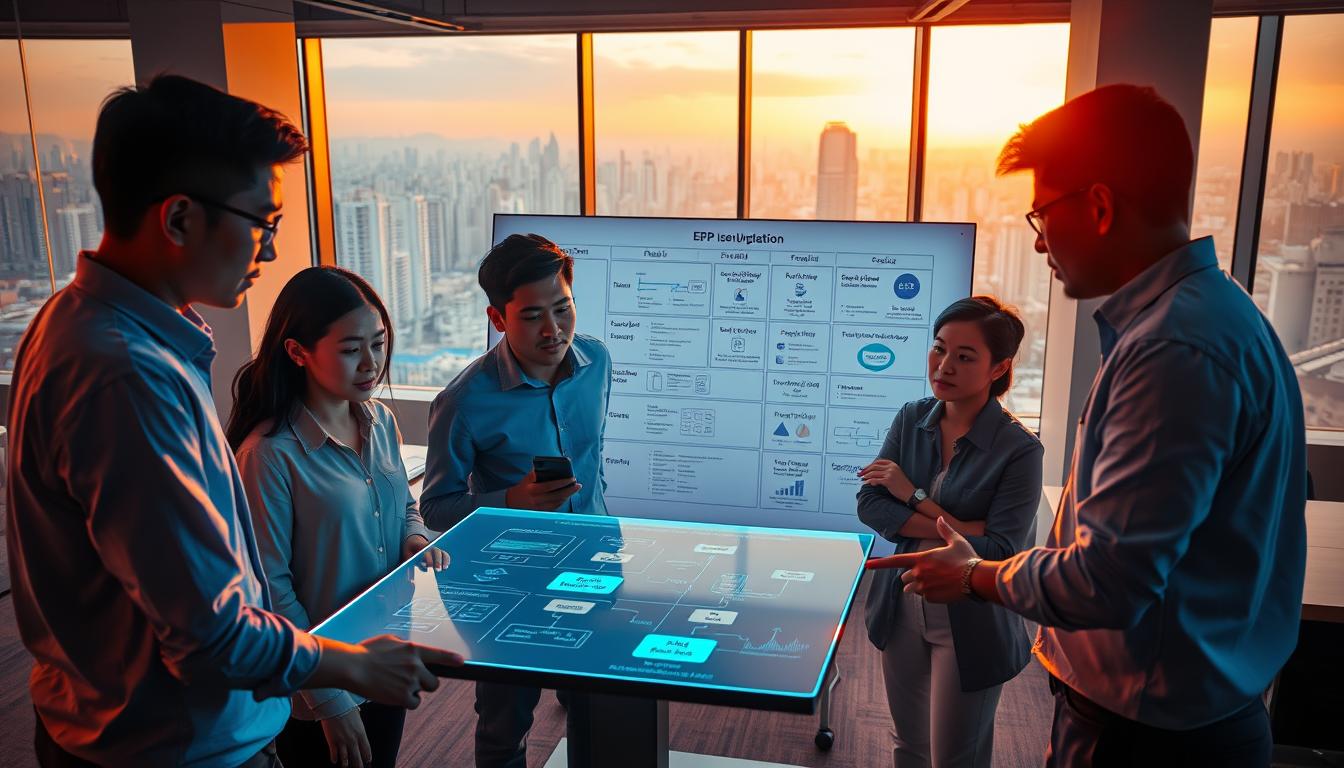Is your current ERP system holding you back? As small and medium enterprises (SMEs) in the Philippines grow, choosing to upgrade becomes harder. Knowing when and why to update can make all the difference.
Before you upgrade, think about how it will affect your daily work. Also, consider the risks like losing data or facing higher costs.
Key Takeaways
- Recognizing the signs that indicate the need for an ERP upgrade is essential for growth.
- Effective evaluation of current systems can prevent detrimental outcomes.
- Choosing the right ERP solution for your needs significantly impacts operational efficiency.
- Implementation strategies are crucial for a smooth transition during upgrades.
- Training and support add value and ensure user adoption of enhanced systems.
- Budget considerations play a vital role in successful ERP upgrades.
- Future-proofing your ERP ensures compatibility with new technologies.
Understanding ERP System Upgrades
ERP systems are key for many businesses. They handle important tasks like finance, sales, and inventory. These systems help businesses work smoothly and make quick decisions.
As the business world changes, systems can become outdated. They might not keep up with new needs.
ERP upgrades are important for keeping things running well. New systems have better interfaces and stronger security. This is crucial for small and medium businesses in fast markets like the Philippines.
Before upgrading, it’s important to check your current system. Knowing what you need helps choose the right upgrades. The right choices can improve how the system works and make users happier.
Signs That Your ERP System Needs an Upgrade
Knowing when to upgrade your ERP system is key to better performance. When your current system can’t handle business growth, you’ll see signs. These signs show it’s time for a new system.
Inability to Keep Up with Growth
A growing business needs an ERP system that grows with it. If your system can’t keep up, you’ll see productivity stay the same while demand goes up. This means your system is not meeting your business needs.
An outdated ERP system can stop your business from growing. It limits your ability to make more money and work more efficiently.
Poor User Experience
User happiness is important in any ERP system. A hard-to-use interface or slow system can make employees unhappy. When users can’t do their jobs well, mistakes happen.
This can hurt your customer service and satisfaction. Making your system easier to use is key to keeping your team happy and productive.
Lack of Real-Time Data
In today’s fast business world, you need data fast. Slow data can slow down your decisions and plans. If you can’t get the latest data, your system might not be up to date.
Getting a system that gives you timely data is important. It helps you make better decisions and grow your business.
Scalability & Upgrades: Why it Matters
Scalability in an ERP system means it can grow with your business. Small businesses in the Philippines often grow fast. This can show the limits of their current systems.
Getting a scalability upgrade is key to avoid problems. An ERP that can’t grow can cause delays and misalignment. This can hurt your profits.
Business leaders need to see the value of ERP benefits for growth. Choosing modern, scalable solutions helps streamline processes. This way, businesses can handle more work without losing efficiency.
The right upgrades make businesses flexible and ready for changes. They help manage future challenges easily.
Evaluating Your Current ERP System
To upgrade your ERP system wisely, you need to evaluate your current one well. This involves checking how it performs and finding any issues that slow down your business.
Assessing Performance Metrics
Performance metrics show if your ERP system is working well for your business. Look at how fast it handles transactions, how many errors it makes, and how happy users are. If these metrics don’t meet your business needs, it might be time for an upgrade.
Identifying System Limitations
Knowing what your system can’t do is key to making it better. Old technology that can’t work with new apps is a big problem. Also, if your system is too manual or can’t handle data well, it’s not meeting your needs. Spotting these issues helps plan a better upgrade for your business.
Choosing the Right ERP Solution
Choosing the right ERP system is key for businesses wanting to improve their efficiency and flexibility. You might need a cloud solution or an on-premise ERP, depending on your business needs. Knowing the differences between these options helps you pick the best one for your goals.
Cloud vs. On-Premise ERP
Cloud-based ERP solutions are flexible and cost-effective, great for small and medium-sized businesses. They let you access the system from anywhere and grow as needed. On the other hand, on-premise ERP systems are good for those who want to customize and control their data closely. This can be vital for certain industries.
Evaluating Vendor Expertise
When picking an ERP vendor, look at their experience. A vendor familiar with your industry knows your specific needs and rules. Working with an experienced vendor makes the setup smoother and ensures the ERP fits your operations well.
Implementation Strategies for a Successful Upgrade
A successful ERP system upgrade relies on solid strategies. These strategies should include strong transition plans. They must gather insights from all stakeholders.
Having key team members involved is crucial. It ensures every part of the upgrade is covered. This makes the process smoother.
Data migration is a key part of these plans. Keeping data integrity during migration is vital for a smooth upgrade. Companies should also focus on user training.
This training helps staff get used to the new system. It reduces frustration as teams adjust to the changes.
Getting feedback in real-time is important, even more so for SMEs in the Philippines. This feedback helps make necessary changes. It prevents disruptions to operations.
Keeping communication open during this time is key. It helps balance daily functions with the transition to the new ERP environment.
Training and Support for Your Team
Upgrading your ERP system is more than just a tech change. It needs ERP training for your team to use it well. Knowing how the system works is key to being efficient and productive. Good training helps your team use the new system smoothly, boosting your work’s quality.
Importance of Proper Training
Good employee support comes from solid training. When your team knows the system, they use it better. This means less stress and more people using it.
Training that shows real-world uses is best. It makes your team familiar with the system and teaches them how to use it best. This makes them feel ready and able to do their jobs well.
Setting Up Support Channels
Having strong support channels is also key. These help when your team faces problems. A helpdesk or online forums can quickly solve issues and answer questions.
It’s important for your team to know help is always there. This keeps morale high and encourages learning. For more on training your team, see this resource on improving employee training in the Philippines.
Cost Considerations for ERP Upgrades
When planning an ERP upgrade, it’s key to understand the costs. This helps businesses improve their performance. The costs include software, technical support, and training for staff.
Finding the Right Budget
To budget for upgrades, list all expected expenses. This includes:
- Licensing fees for new software
- Training sessions for employees
- Technical support and consulting fees
- Potential downtime during the transition
Make sure the budget covers these costs. Also, think about the long-term savings from better operations. A good upgrade can cut down on ongoing problems and boost productivity. This way, businesses can manage costs now and gain in the future.
Future-Proofing Your ERP System
In today’s fast-changing business world, future-proofing ERP systems is key for success. It’s not just about the initial cost; it’s about ongoing updates and growth. This forward-thinking approach helps businesses stay ahead and grow for the long haul.
Keeping Up with Technological Advancements
Adding new tech like AI and machine learning to ERP systems is a big plus. These tools help automate tasks, make better decisions, and boost efficiency. Keeping up with these technological advancements is vital for future-proofing ERP.
For long-term planning, businesses should regularly check their ERP setup. This helps spot any missing pieces for new tech. By always improving, companies can meet and beat customer needs.
Businesses should act ahead of time, not just react. By focusing on future-proofing ERP, companies can keep up with market changes. Upgrading and adding new tech is key for lasting success in a complex world. Using cloud-based solutions can also help strengthen operations.
Conclusion
Upgrading an ERP system is key for SMEs wanting to grow and evolve. It helps them stay competitive in the Philippines. The process starts with knowing when to upgrade and ensuring the system can grow with the business.
Training and support are also crucial. They help teams adjust smoothly to the new system. This shows that ERP upgrades are more than keeping up. They are about setting a business up for long-term success.
The main aim is to boost growth and keep operations efficient. It’s about being ready for future challenges. Investing in an ERP system means staying ahead in a changing market.




